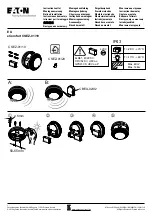
ISW-EN1242 Installation Guide
Smoke Detector-Transmitter
Overview
The ISW-EN1242 Smoke Detector-Transmitter is a wireless, battery-powered
photoelectric smoke sensor. Under non-alarm conditions, the LED flashes
once every 8 sec while the sensor monitors the surrounding conditions. When
the sensor detects smoke, the LED lights, the built-in sounder beeps loudly,
and the detector sends an alarm signal. The smoke sensor is powered by two
3 V lithium batteries.
1.0
Open the Detector-Transmitter Housing
1.
Using a small screwdriver, press the sensor cap release tab and turn the
cap approximately 25 mm (1 in.) counter-clockwise to remove the cap
(
Figure 1
).
Figure 1: Remove the Sensor Cap
2.
Place both thumbs on opposite sides of the optical chamber and push
down to detach the sensor housing (
Figure 2
).
Figure 2: Push Down the Optical Chamber
2.0
Mount the Housing Back Plate
Use the provided anchors and screws to mount the smoke detector, while
following these best practices:
Regulations pertaining to smoke sensor installations vary. For
more information, contact your local fire department or local
authority having jurisdiction.
•
Install a minimum of two smoke sensors in any household.
•
Put a smoke sensor in the hallway outside of every bedroom area.
•
Put a smoke sensor on every level of a multi-level residence.
•
In rooms with sloped ceilings, install smoke sensors 0.9 m (3 ft)
measured down from the highest point of the ceiling.
•
Install basement sensors on the ceiling as close to the center of the
room as possible. If this is not practical, install on the ceiling no closer
than 10 cm (4 in.) from any wall or corner.
•
If ceiling mounting is not practical, install the sensor on an inside wall
between 10 and 15 cm (4 and 6 in.) from the ceiling.
•
Put smoke sensors at both ends of a bedroom hallway if the hallway is
more than 9 m (30 feet) long. Large rooms over 84 square meters (900
square feet) require more than a single sensor.
•
Areas with rough ceilings or short walls coming down from the ceiling
require additional smoke sensors.
•
Install second-floor smoke sensors on the ceiling at the top of the first-
to-second floor stairwell. Ensure that no door or other obstruction
blocks the path of smoke to the sensor.
Do not install sensors:
•
On a drop ceiling tile. Mount them on a metal runner.
•
In or near areas such as kitchens or garages, where smoke or vehicle
exhausts normally occur (protect these areas with heat-detection
devices, not with smoke sensors); near furnaces, hot water heaters, or
gas space heaters.
•
In damp or very humid areas, or next to bathrooms with showers. Install
sensors at least 1.5 m (5 ft) away from bathrooms.
•
In very cold or very hot areas. Refer to
Section 8.0
on page 2 for
operating temperature specifications.
•
In dusty, dirty, or insect-infested areas.
•
Near fresh air inlets or returns or excessively drafty areas. Air
conditioners, heater, fans, and fresh air intakes and returns can drive
smoke away from smoke sensors.
•
In dead air spaces at the top of a peaked ceiling or a wall or ceiling
intersection. Dead air might prevent smoke from reaching smoke
sensors.
•
Near fluorescent light fixtures. Install smoke sensors at least 3 m (10 ft)
away from fluorescent light fixtures.
•
Between protruding ceiling structures such as beams or walls which
might prohibit smoke from reaching the sensors.
All sensors are subject to possible compromise or failure-to-
warn for a variety of reasons. For example, smoke sensors
cannot detect smoke in chimneys, walls, roofs, or smoke
blocked by a closed door; sensors might not detect smoke on
other levels of a building; sensors might not warn in time
when fires are caused by smoking in bed, explosions,
improper storage of flammables, overloaded electrical
circuits, or other hazardous conditions.
3.0
Configure the Detector
Figure 3: Detector-Transmitter Components
LOW BAT
CLEAN
NZ
AU
1
2
3
1 -
LOW BAT/CLEAN pins (default = CLEAN)
2 -
Frequency Band pins
3 -
Reset button
3.1
Select the Frequency Band
Select the appropriate frequency band for your geographic area.
1.
Place a selection jumper on the appropriate Frequency Band pins (refer
to
Figure 3
). The default is no jumper (North America).
•
Place the jumper on the left two pins, marked AU, to set the
frequency range to 915-928 MHz for Australia.
•
Place the jumper on the right two pins, marked NZ, to set the
frequency range to 921-928 MHz for New Zealand.
•
Leave the jumper off the pins to set the frequency range to 902-
928 MHz for North America.
2.
Press the Reset button.
When pressing the Reset button, do not touch the Frequency
Band pins. Touching the Frequency Band pins while pressing
the Reset button can inadvertently set the detector to the
wrong frequency band.
3.2
Set Clean/Low Battery Reporting
With the factory default CLEAN setting (refer to
Figure 3
), the smoke detector
combines the low battery signal with a signal indicating that the detector
needs cleaning. If multiple-condition indication is not desired, disable
wireless reporting of the CLEAN status by moving the jumper to LOW BAT.
With the LOW BAT setting, the detector sends only a low battery signal.
If CLEAN notification is disabled, the sensitivity test still
indicates the sensor condition.
4.0
Install the Battery
1.
Rotate the sensor housing counterclockwise approximately 25 mm
(1 in.), and then detach it from the mounting base.
2.
Remove the battery compartment cover (
Figure 4
on page 2).




















